Liquid CO2 Phase-Transition Rock Fracturing: A Novel Technology for Safe Rock Excavation
Abstract
:1. Introduction
2. Liquid CO2 Phase-Transition Rock Fracturing
2.1. CO2 Phase-Transition Fracturing Device
2.2. Principle of the CO2 Phase-Transition Fracturing
2.3. Advantages of CO2 Phase-Transition Fracturing
- (1)
- High safety and reliable operations
- (2)
- Controllable fracturing energy
- (3)
- Reusable main parts
- (4)
- Relatively low safety control levels
3. Field Test Study on Liquid CO2 Phase-Transition Rock Fracturing
3.1. Study Area
3.2. Test Program
3.3. Fracturing Effects
3.3.1. Acquisition of the Feature Information of the Rock Masses after Fracturing
3.3.2. Distribution Characteristics of the Granularity of the Rock after Fracturing
3.4. Vibration Monitoring
3.4.1. Velocity Analysis
3.4.2. Energy Analysis
4. Conclusions
- During the process of the liquid CO2 phase-transition fracturing, there were both dynamic actions of rock breakages by excitation stress wave impacts, and quasi-static actions of rock breakage by gasification expansion wedges. It was confirmed in this study that liquid CO2 phase-transition fracturing technology could be applied in surface rock excavation and will provide a new idea for the follow-up activities of similar engineering construction projects.
- It was determined from these results that the liquid CO2 phase-transition fracturing technology method had displayed ideal effects. Further, the granular distributions of fractured rock blocks had conformed to the fractal law. It could be seen that the higher the proportion of small fragments was, the greater the fractal dimensions would be. This study’s quantitative evaluation of the fracturing granularity will potentially provide important technical support for the subsequent optimization of drill-hole arrangements to improve fracturing effects.
- The duration of the CO2 fracturing vibration waves was short (approximately 0.2 s), with fast attenuation and a small number of high-frequency components. The duration of the main vibration phases was approximately 0.1 s, and the distributions of the frequency bands were observed to be different. Overall, the energy dominant frequency bands of the CO2 fracturing vibration waves were determined to range between 0 and 20 Hz.
Author Contributions
Funding
Institutional Review Board Statement
Informed Consent Statement
Conflicts of Interest
References
- Caldwell, T. A Comparison of Non-Explosive Rock Breaking Techniques. Bachelor’s Thesis, School of Engineering, The University of Queensland, Brisbane, Australia, 2004. [Google Scholar]
- Peng, H.D.; Liu, D.W.; Chu, F.J.; Jian, Y.H. Test on high pressure gas expansion rock fragmentation in hard rock tunnel. Rock Soil Mech. 2018, 39, 242–248. [Google Scholar]
- Ghose, A.K.; Res, J.; Kotwica, K. Non-explosive rock excavation—A critique. J. Mines Met. Fuels 1999, 03, 67–74. [Google Scholar]
- Roy, P.P.; Ghose, A.K. Rock excavation without explosives—The global scenario. J. Mines Met. Fuels 2003, 322, 364–369. [Google Scholar]
- Wang, S.D. Application of non-blasting rock breaking technology in foreign countries. Nonferrous Met. Des. 2000, 57, 40–44. [Google Scholar]
- Yin, C.F.; Yang, Y.; Shen, R.G.; Yang, Y.M.; Jiang, H.L. Review of non-explosive rock breaking. China Sci. Technol. Inf. 2015, 21, 93–94. [Google Scholar]
- Xie, X.H.; Zhang, X.K. Review of the study of non-explosive rock breaking. Coal Mine Blasting 2017, 6, 19–23. [Google Scholar]
- Peng, K.W. The direction control of cut-plane during digging building stone with non-explosive demolishing angent. Rock Soil Mech. 1990, 2, 79–84. [Google Scholar]
- Zhang, K.Z. Application of Static Fragmentation Technique in Excavation of Hard Rocks. Blasting 2003, 4, 96–97. [Google Scholar]
- Lu, T.; Wang, Z.; Yang, H.; Yuan, P.; Han, Y.; Sun, X. Improvement of coal seam gas drainage by under-panel cross-strata stimulation using highly pressurized gas. Int. J. Rock Mech. Min. Sci. 2015, 77, 300–312. [Google Scholar] [CrossRef]
- Zhou, K.P.; Ke, B.; Li, J.L.; Zhang, Y.N.; Cheng, L. Pressure dynamic response and explosion energy of liquid carbon dioxide blasting system. Blasting 2017, 34, 7–13. [Google Scholar]
- Schooler, D.R. The Use of Carbon Dioxide for Dislodging Coal in Mines. 1944. Available online: https://scholarsmine.mst.edu/professional_theses/224/ (accessed on 15 October 2021).
- Holmberg, R.; White, T. Cardox system brings benefits in the mining of large coal. Coal Int. 1995, 243, 31–33. [Google Scholar]
- Goodarzi, M.; Mohammadi, S.; Jafari, A. Numerical analysis of rock fracturing by gas pressure using the extended finite element method. Pet. Sci. 2015, 12, 304–315. [Google Scholar] [CrossRef] [Green Version]
- Zhu, W.C.; Gai, D.; Wei, C.H.; Li, S.G. High-pressure air blasting experiments on concrete and implications for enhanced coal gas drainage. J. Nat. Gas Sci. Eng. 2016, 36, 1253–1263. [Google Scholar] [CrossRef] [Green Version]
- Donzé, F.V.; Bouchez, J.; Magnier, S.A. Modeling fractures in rock blasting. Int. J. Rock Mech. Min. Sci. 1997, 34, 1153–1163. [Google Scholar] [CrossRef]
- Singh, S.P. Non-explosive applications of the PCF concept for underground excavation. Tunn. Undergr. Space Technol. 1998, 13, 305–311. [Google Scholar] [CrossRef]
- Zhou, X.H.; Men, J.L.; Song, D.P.; Li, C.Y. Research on optimal borehole parameters of antireflection in coal seam by liquid CO2 blasting. Chin. J. Rock Mech. Eng. 2016, 35, 524–529. [Google Scholar]
- Cho, S.H.; Nakamura, Y.; Kaneko, K. Dynamic fracture process analysis of rock subjected to a stress wave and gas pressurization. Int. J. Rock Mech. Min. Sci. 2004, 41, 439. [Google Scholar] [CrossRef]
- An, F.H.; Cheng, Y.P.; Liang, W.; Wei, L. A numerical model for outburst including the effect of adsorbed gas on coal deformation and mechanical properties. Comput. Geotech. 2013, 54, 222–231. [Google Scholar] [CrossRef]
- Akcin, N.A. Optimun conditions and results form the application of the air blasting excavation system. Miner. Resour. Eng. 2000, 9, 323–334. [Google Scholar] [CrossRef]
- Cao, Y.; Zhang, J.; Hong, Z.; Fu, G.; Lin, T.; Liu, S. CO2 gas fracturing: A novel reservoir stimulation technology in low permeability gassy coal seams. Fuel 2017, 203, 197–207. [Google Scholar] [CrossRef]
- Guo, Z.X. Liquid carbon dioxide blasting tube and field test blasting. Blasting 1994, 03, 72–74. [Google Scholar]
- Xie, X.F.; Li, X.B.; Li, Q.Y.; Ma, H.P.; Liu, X.X. Liquid CO2 phase-transforming rock fracturing technology in pile-well excavation. J. Cent. South Univ. (Sci. Technol.) 2018, 49, 2031–2038. [Google Scholar]
- Mohammadi, S.; Pooladi, A. A two-mesh coupled gas flow–solid interaction model for 2D blast analysis in fractured media. Finite Elem. Anal. Des. 2012, 50, 48–69. [Google Scholar] [CrossRef]
- Plata, M.J.; Castillo, R.D.; Mendoza, S.A. High Energy Gas Fracturing: A Technique of Hydraulic Prefracturing To Reduce the Pressure Losses by Friction in the Near Wellbore—A Colombian Field Application. In Proceedings of the SPE Latin America and Caribbean Petroleum Engineering Conference, Mexico City, Mexico, 16–18 April 2012. [Google Scholar]
- Pang, Z.N.; Zhao, X.; Zou, D.J. The research of rectifying image deviation for UAV. Electron. Prod. Reliab. Environ. Test. 2009, 27, 14–16. [Google Scholar]
- Ouchterlony, F. Influence of blasting on the size of distribution of muckpile fragments. Can. J. Earth Sci. 2011, 28, 1285–1300. [Google Scholar]
- Gao, F.; Xie, H.P.; Zhao, P. Fractal properties of size-frequency distribution of rock fragments and the influence of meso-structure. Chin. J. Rock Mech. Eng. 1994, 3, 240–246. [Google Scholar]
- Xie, X.P.; Xie, Y. Application of fractional method for forecasting rock blasting fragmentation. Eng. Blasting 1995, 01, 26–32. [Google Scholar]
- Ding, T. The Study of Fractional Model of Blasting Rock Fragmentation Distribution. Master’s Thesis, Liaoning Technical University, Fuxin, China, 2000. [Google Scholar]
- Zhao, M. Study on Ore Rock Pile Distribution Based on Fractal Theory. Master’s Thesis, Inner Mongolia University of Science&Technology, Baotou, China, 2015. [Google Scholar]
- Huang, N.E.; Wu, Z. A review on Hilbert-Huang transform: Method and its applications to geophysical studies. Rev. Geophys. 2008, 46, RG2006. [Google Scholar] [CrossRef] [Green Version]
- Zhang, R.R.; Asce, M.; Ma, S.; Safak, E.; Hartzell, S. Hilbert-Huang Transform Analysis of Dynamic and Earthquake Motion Recordings. J. Eng. Mech. 2003, 129, 861–875. [Google Scholar] [CrossRef]
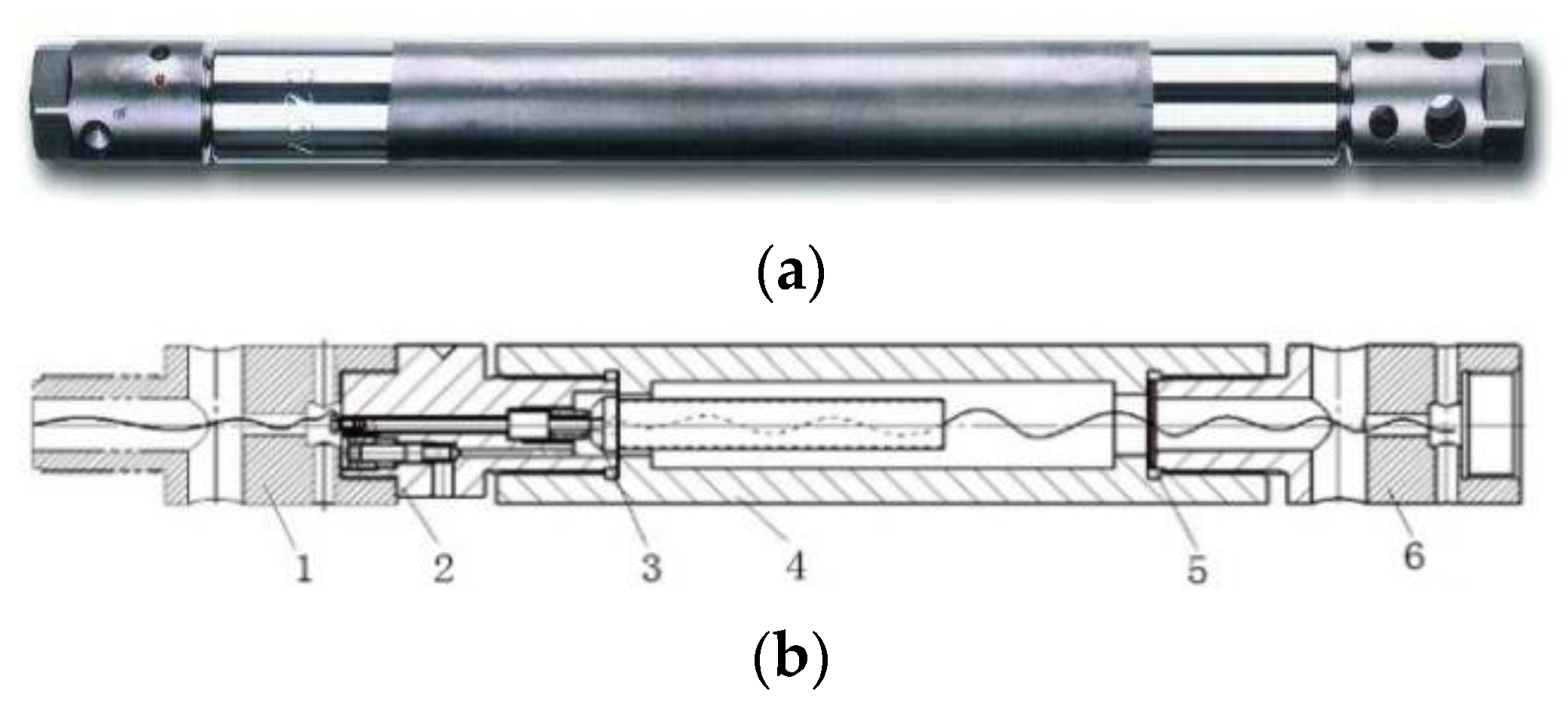


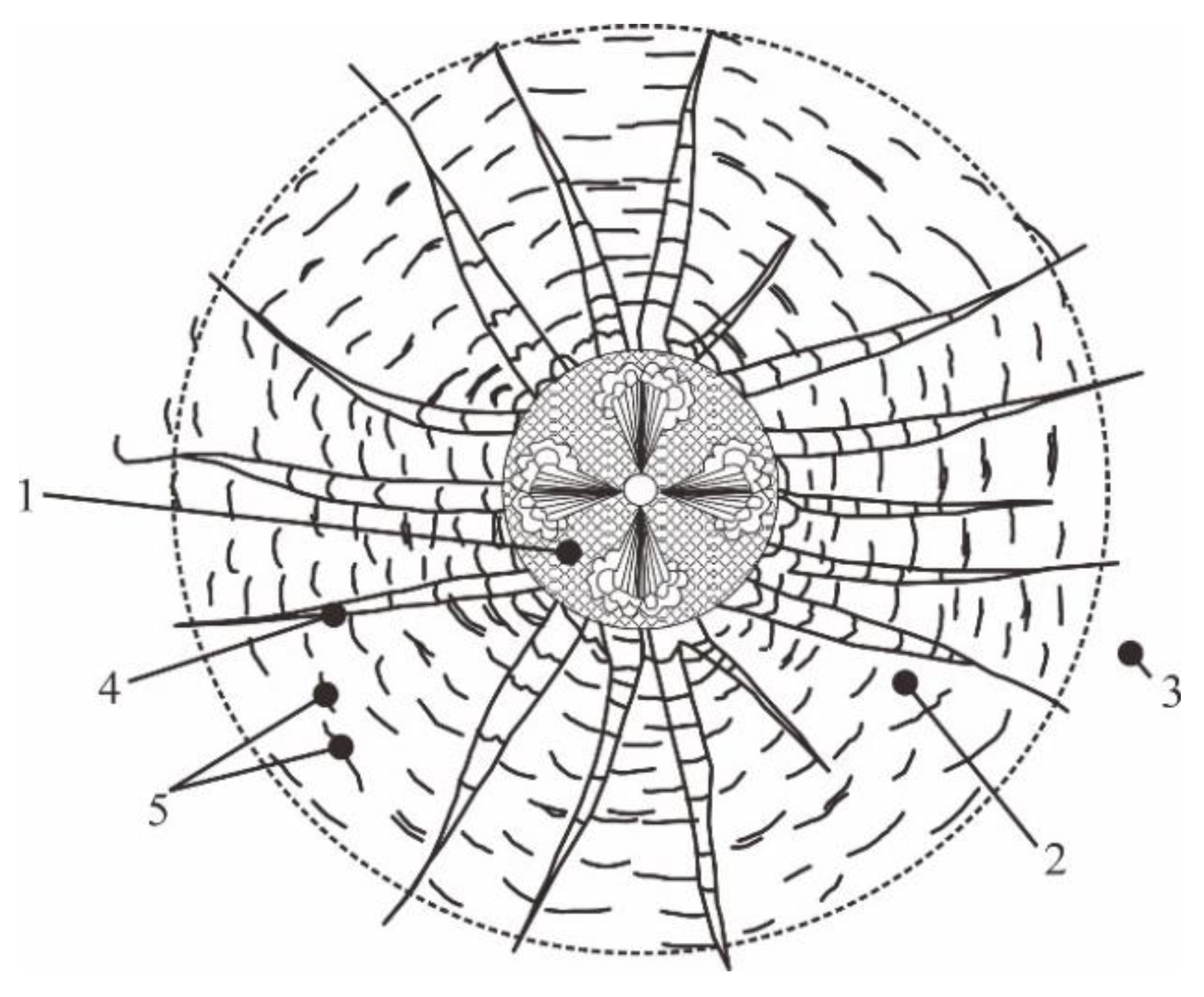

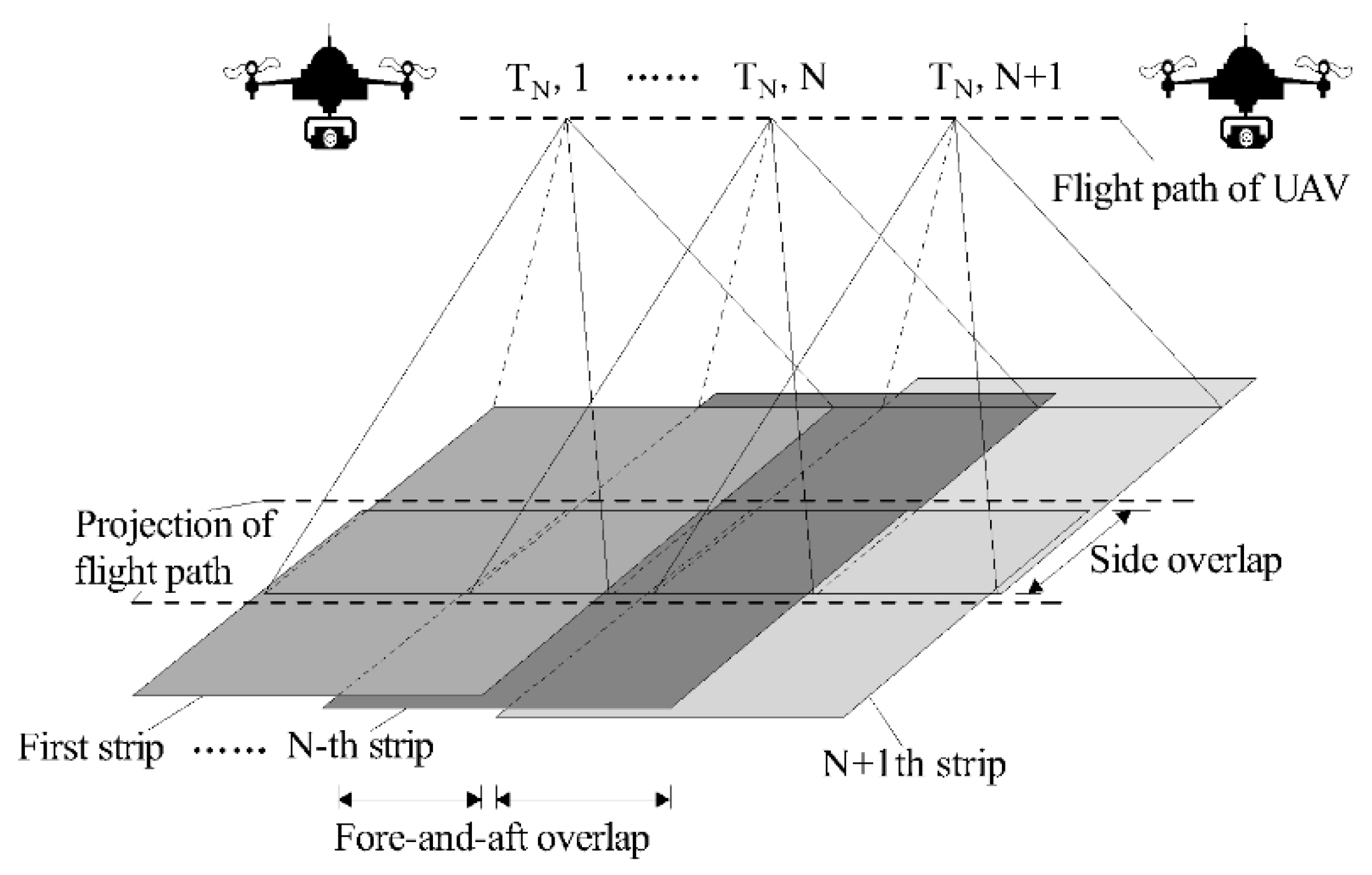

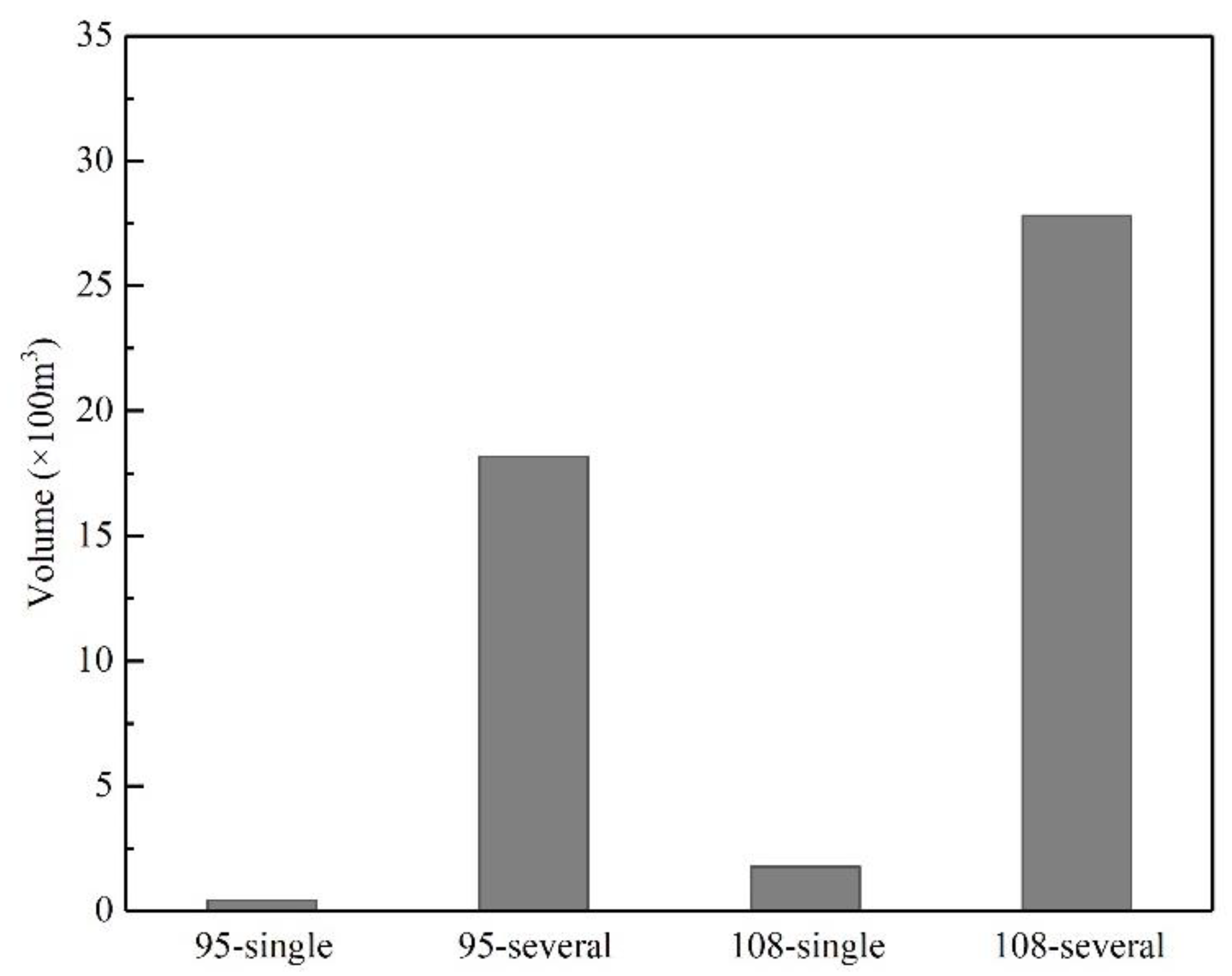
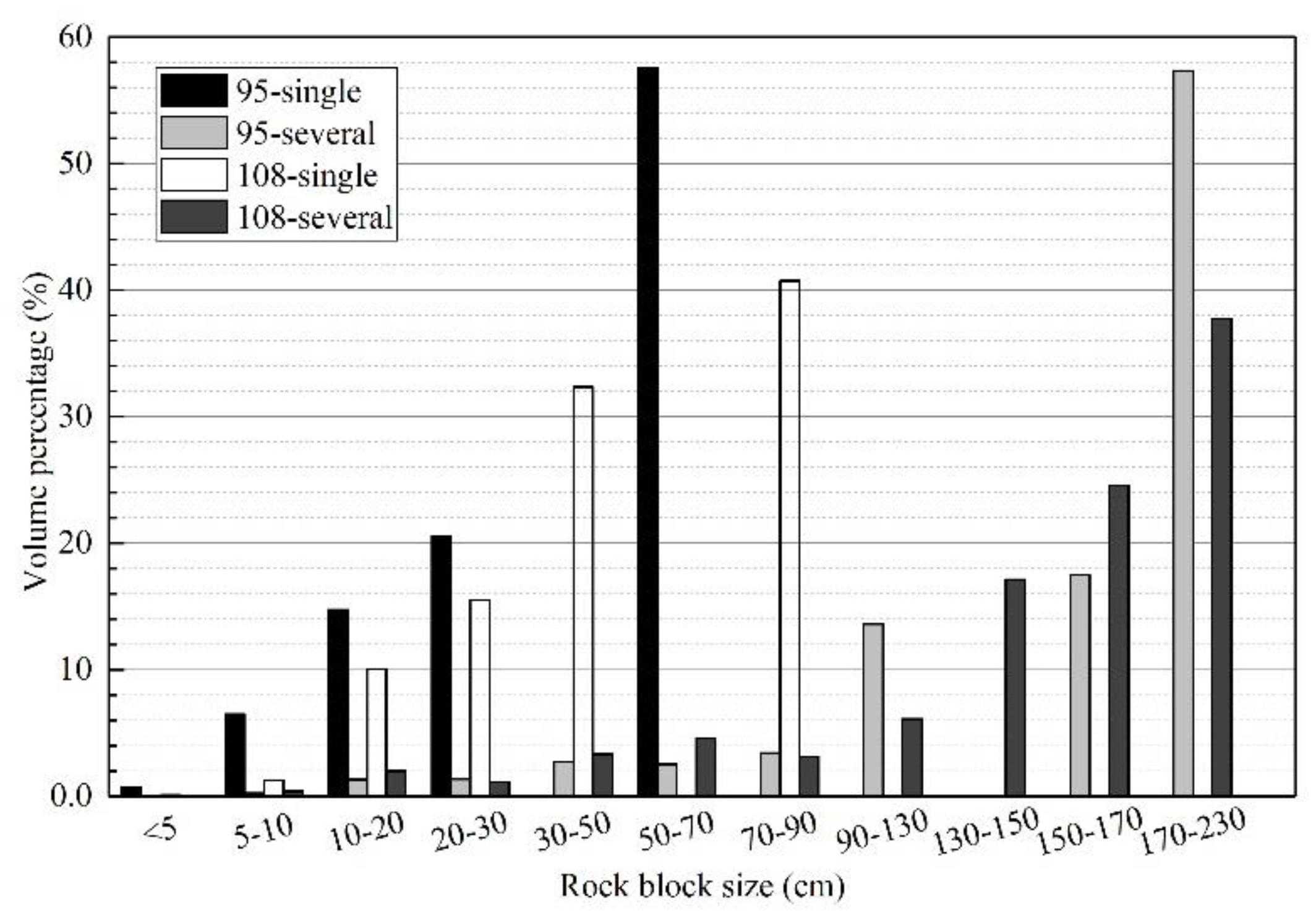



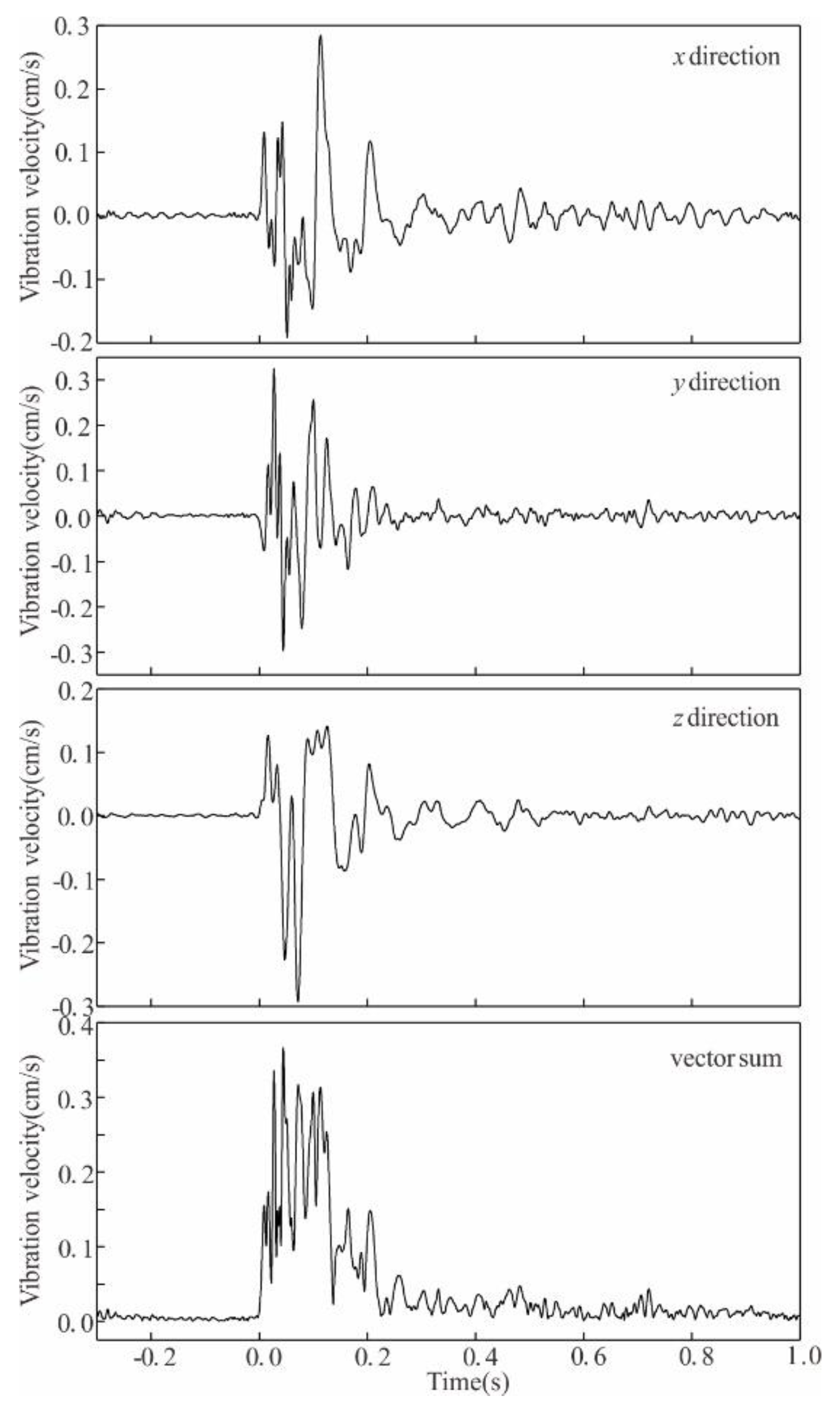

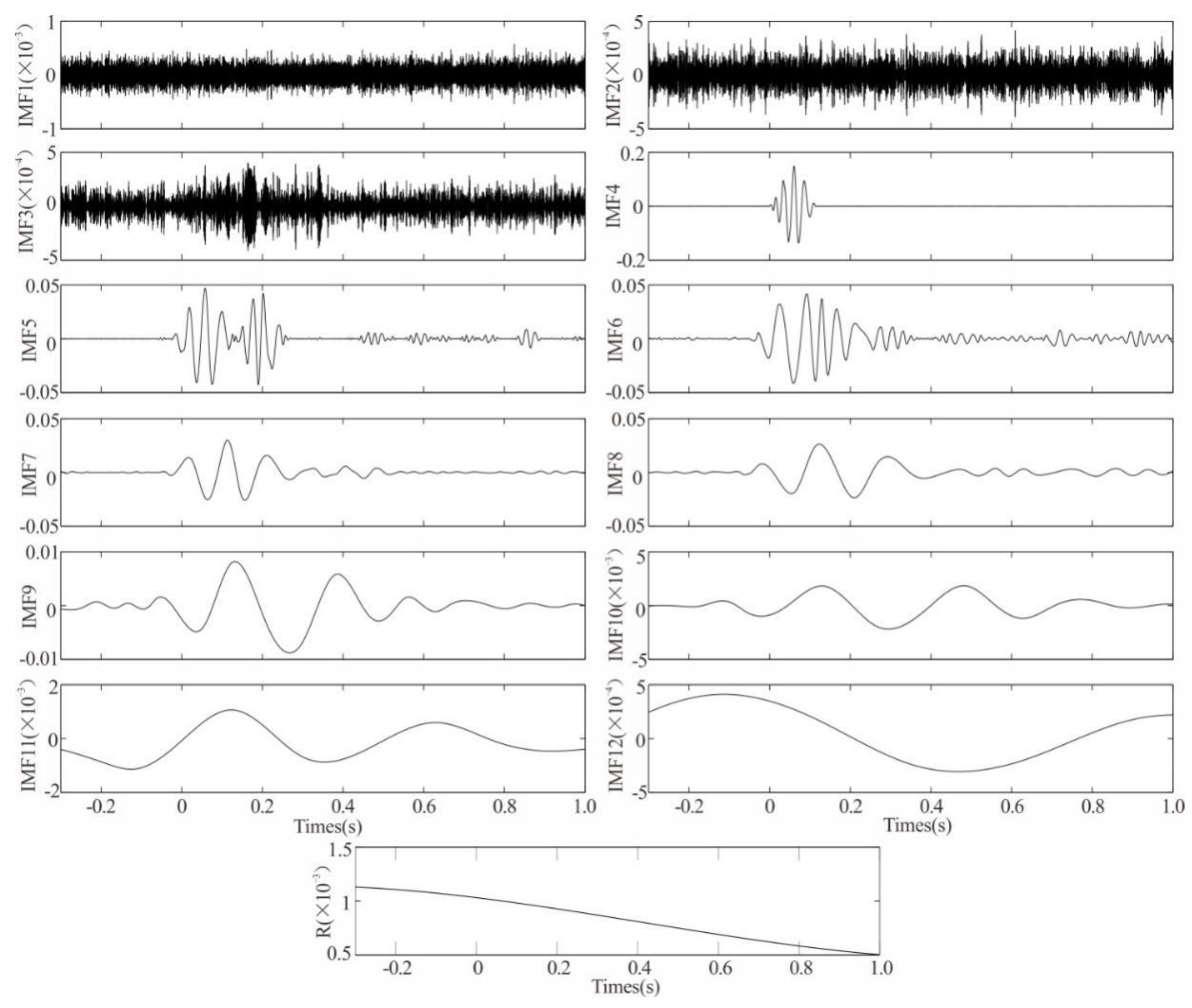

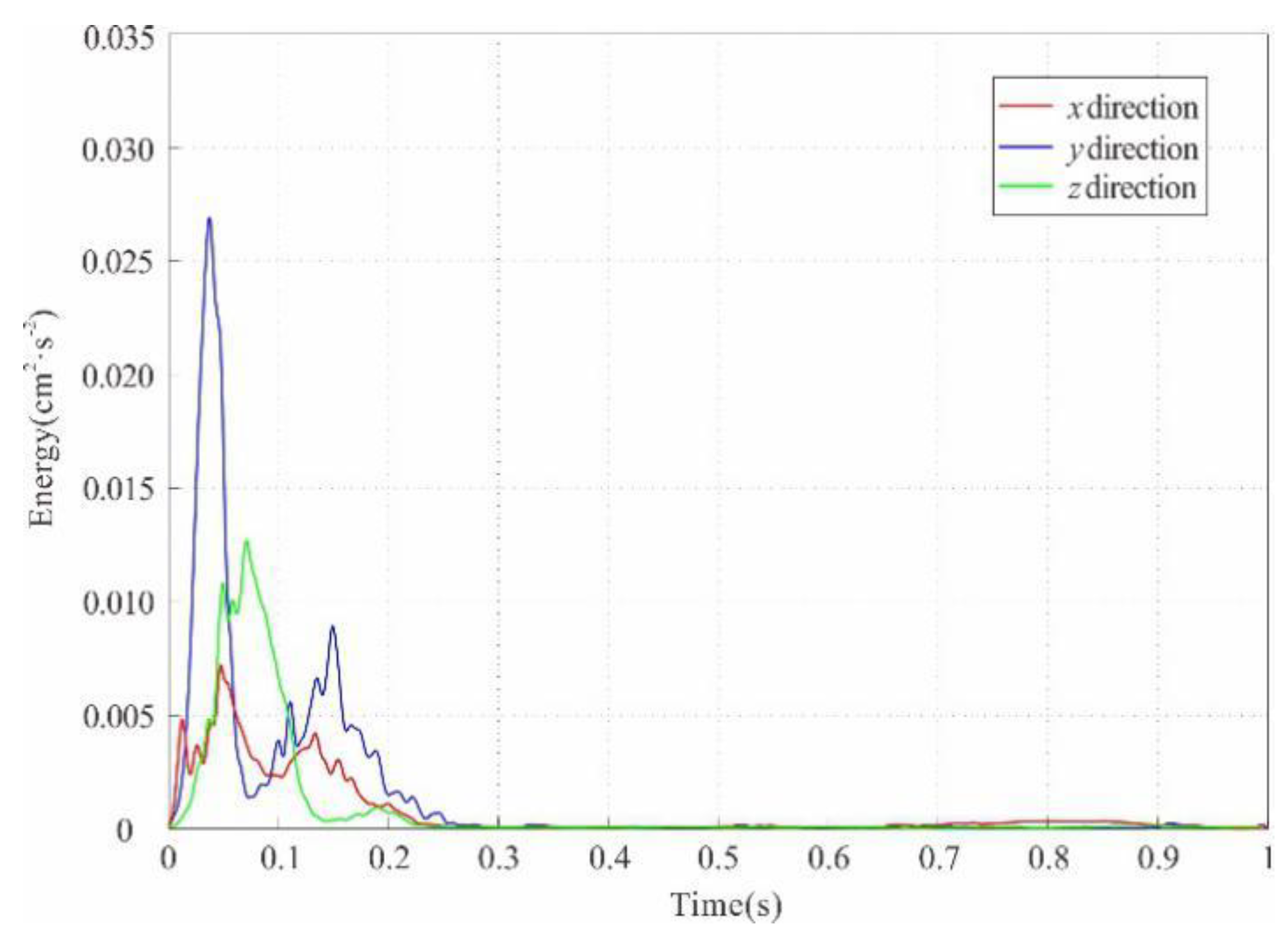
| Item | Type 95 | Type 108 |
|---|---|---|
| Outer diameter of CO2 phase-transition fracturing device (mm) | 95 | 108 |
| Length of CO2 phase-transition fracturing device (mm) | 1300 | 2000 |
| Weight of single CO2 phase-transition fracturing device (kg) | 44 | 100 |
| Drill size (mm) | 120 | 140 |
| Number of single cracked holes | Several | Single |
| Filling volume of liquid CO2 | 2.5 | 7 |
| Item | 95-Single | 95-Several | 108-Single | 108-Several |
|---|---|---|---|---|
| Diameter of drilling hole (mm) | 120 | 120 | 140 | 140 |
| Depth of drilling hole (m) | 4 | 4 | 4 | 4 |
| Number of single cracked holes | 2 | 2 | 1 | 1 |
| Number of drilling hole | 1 | 13 | 1 | 13 |
| Distance of drilling hole (Average m) | 0 | 1.5 | 0 | 1.5 |
| Row spacing of drilling hole (Average m) | 0 | 1.5 | 0 | 1.5 |
| Regional height facing vacancy (m) | 5 | 5 | 5 | 5 |
| Minimum distance of resistance line (Average m) | 0.3 | 0.3 | 0.3 | 0.3 |
| Test Project | Cumulative Percentage of Volume under the Rock Sieve/% | b | Fractal Dimension (D) | Correlation Coefficient | ||||||||||
|---|---|---|---|---|---|---|---|---|---|---|---|---|---|---|
| <5 | <10 | <20 | <30 | <50 | <70 | <90 | <130 | <150 | <190 | <230 | ||||
| 95-type single-hole | 0.71 | 7.19 | 21.92 | 42.45 | 42.45 | 99.99 | 2.030 | 0.970 | 0.982 | |||||
| 95-type several-hole | 0.01 | 0.26 | 1.56 | 2.90 | 5.59 | 8.10 | 11.52 | 25.14 | 25.14 | 42.64 | 100.00 | 2.073 | 0.927 | 0.978 |
| 108-type single-hole | 0.08 | 1.36 | 11.39 | 26.89 | 59.26 | 100.00 | 2.817 | 0.183 | 0.988 | |||||
| 108-type several-hole | 0.02 | 0.40 | 2.38 | 3.49 | 6.79 | 11.36 | 14.45 | 20.53 | 37.67 | 99.99 | 1.959 | 1.041 | 0.978 | |
Publisher’s Note: MDPI stays neutral with regard to jurisdictional claims in published maps and institutional affiliations. |
© 2021 by the authors. Licensee MDPI, Basel, Switzerland. This article is an open access article distributed under the terms and conditions of the Creative Commons Attribution (CC BY) license (https://creativecommons.org/licenses/by/4.0/).
Share and Cite
Sui, H.; Su, T.; Hu, R.; Yang, K.; Cheng, Y. Liquid CO2 Phase-Transition Rock Fracturing: A Novel Technology for Safe Rock Excavation. Appl. Sci. 2022, 12, 68. https://doi.org/10.3390/app12010068
Sui H, Su T, Hu R, Yang K, Cheng Y. Liquid CO2 Phase-Transition Rock Fracturing: A Novel Technology for Safe Rock Excavation. Applied Sciences. 2022; 12(1):68. https://doi.org/10.3390/app12010068
Chicago/Turabian StyleSui, Haoyue, Tianming Su, Ruilin Hu, Ke Yang, and Yaxing Cheng. 2022. "Liquid CO2 Phase-Transition Rock Fracturing: A Novel Technology for Safe Rock Excavation" Applied Sciences 12, no. 1: 68. https://doi.org/10.3390/app12010068
APA StyleSui, H., Su, T., Hu, R., Yang, K., & Cheng, Y. (2022). Liquid CO2 Phase-Transition Rock Fracturing: A Novel Technology for Safe Rock Excavation. Applied Sciences, 12(1), 68. https://doi.org/10.3390/app12010068






